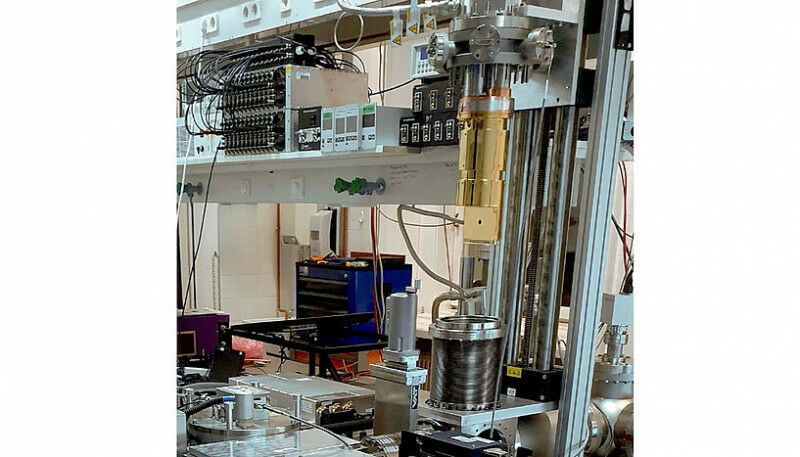博文
量子物理学:超导纳米线检测单个蛋白质离子
||
量子物理学:超导纳米线检测单个蛋白质离子
诸平

据奥地利维也纳大学(University of Vienna, Boltzmanngasse, Vienna, Austria.)2023年12月4日提供的消息,由维也纳大学量子物理学家马库斯·阿恩特(Markus Arndt)领导的国际研究团队在蛋白质离子检测方面取得突破:超导纳米线探测器凭借其高能量灵敏度,实现了蛋白质离子检测的突破(Quantum physics: Superconducting Nanowires Detect Single Protein Ions)。几乎100%的量子效率,比传统离子探测器在低能量下的探测效率高出1000倍。与传统探测器相比,它们还可以通过冲击能量来区分大分子。这允许更灵敏地检测蛋白质,并提供质谱分析中的附加信息。这项研究的结果于2023年12月1日已经在在《科学进展》(Science Advances)杂志网站发表——Marcel Straus, Armin Shayeghi, Martin F. X. Mauser, Philipp Geyer, Tim Kostersitz, Julia Salapa, Olexandr Dobrovolskiy, Steven Daly, Jan Commandeur, Yong Hua, Valentin Köhler, Marcel Mayor, Jad Benserhir, Claudio Bruschini, Edoardo Charbon, Mario Castaneda, Monique Gevers, Ronan Gourgues, Nima Kalhor, Andreas Fognini, Markus Arndt. Highly sensitive single molecule detection of macromolecule ion beams. Science Advances, 1 Dec 2023, Vol 9, Issue 48. DOI: 10.1126/sciadv.adj2801. https://www.science.org/doi/10.1126/sciadv.adj2801
参与此项研究的除了来自维也纳大学的研究人员之外,还有来自奥地利科学院(Austrian Academy of Sciences, Boltzmanngasse, Vienna, Austria)、荷兰MSVision(MSVision, Televisieweg 40, 1322 AM Almere, The Netherlands)、荷兰单量子(Single Quantum, Rotterdamseweg 394, 2629 HH, Delft, The Netherlands);瑞士巴塞尔大学(University of Basel, St. Johannsring 19, CH-4056 Basel, Switzerland)以及瑞士洛桑联邦理工学院(école Polytechnique Fédérale de Lausanne简称EPFL, Rue de la Maladière 71b, CH-2002 Neuchatel, Switzerland)的研究人员。
大分子的检测、识别和分析在生命科学的许多领域都很有趣,包括蛋白质研究、诊断和分析。质谱法通常用作检测系统即一种通常根据带电粒子(离子)的质荷比分离带电粒子(离子)并测量检测器生成的信号强度的方法。这提供了有关不同类型离子的相对丰度的信息,从而提供了样品组成的信息。然而,传统探测器只能对具有高冲击能量的粒子实现高探测效率和空间分辨率——这一限制现已被使用超导纳米线探测器的国际研究团队克服。
低能粒子的合力(Joined forces for low energy particles)
在当前的研究中,由维也纳大学与代尔夫特的单量子、EPFL、MSVision和巴塞尔大学的合作伙伴协调的欧洲联盟首次展示了超导纳米线的使用所谓的四极杆质谱(quadrupole mass spectrometry)中蛋白质束的优秀检测器。待分析样品中的离子被送入四极杆质谱仪并进行过滤。“如果我们现在使用超导纳米线而不是传统探测器,我们甚至可以识别以低动能撞击探测器的粒子,”维也纳大学物理学院量子纳米物理小组(Quantum Nanophysics Group at the Faculty of Physics at the University of Vienna)的项目负责人马库斯·阿恩特 (Markus Arndt) 解释道。这是通过纳米线探测器的特殊材料特性(超导性)实现的。
借助超导技术实现这一目标(Getting there with superconductivity)
这种检测方法的关键是纳米线在非常低的温度下进入超导状态,在这种状态下它们失去电阻并允许无损电流流动。进入离子对超导纳米线的激发导致返回到正常导电状态(量子跃迁)。在此转变期间纳米线电特性的变化被解释为检测信号。“通过我们使用的纳米线探测器,”第一作者马塞尔· 施特劳斯(Marcel Strauß / Marcel Straus)说,“我们利用了从超导到正常导电状态的量子跃迁,因此可以比传统离子探测器性能高出三个数量级。” 事实上,纳米线探测器在极低的冲击能量下具有显著的量子产率-并重新定义了传统探测器的可能性:“此外,配备这种量子传感器的质谱仪不仅可以根据分子的质量到电荷状态来区分分子,还可以根据分子的动能对它们进行分类。这改善了检测并提供了更好的空间分辨率的可能性,”马塞尔·施特劳斯说道。纳米线探测器可以在质谱、分子光谱、分子偏转或分子量子干涉测量中找到新的应用,这些领域需要高效率和良好的分辨率,特别是在低冲击能量下。图 2(Fig. 2)是用超导纳米线计数单个蛋白质。
团队和资金(Team & Funding)
单量子(Single Quantum)领导超导纳米线探测器的研究,洛桑联邦理工学院的专家提供超冷电子学,MSVISION 是质谱专家,巴塞尔大学的专家负责化学合成和蛋白质功能化。维也纳大学将所有组件与其在量子光学、分子束和超导性方面的专业知识结合在一起。
本研究得到了戈登和贝蒂摩尔基金会 (Gordon and Betty Moore Foundation: 10771)、欧盟地平线2020框架计划(European Union’s Horizon 2020 Framework Programme: 860713 and 777222)的资助。
上述介绍,仅供参考。欲了解更多信息,敬请注意浏览原文或者相关报道。
The analysis of proteins in the gas phase benefits from detectors that exhibit high efficiency and precise spatial resolution. Although modern secondary electron multipliers already address numerous analytical requirements, additional methods are desired for macromolecules at energies lower than currently used in post-acceleration detection. Previous studies have proven the sensitivity of superconducting detectors to high-energy particles in time-of-flight mass spectrometry. Here, we demonstrate that superconducting nanowire detectors are exceptionally well suited for quadrupole mass spectrometry and exhibit an outstanding quantum yield at low-impact energies. At energies as low as 100 eV, the sensitivity of these detectors surpasses conventional ion detectors by three orders of magnitude, and they offer the possibility to discriminate molecules by their impact energy and charge. We demonstrate three developments with these compact and sensitive devices, the recording of 2D ion beam profiles, photochemistry experiments in the gas phase, and advanced cryogenic electronics to pave the way toward highly integrated detectors.
https://blog.sciencenet.cn/blog-212210-1412428.html
上一篇:在土壤中接种菌根真菌可使植物产量增加40%
下一篇:新理论将爱因斯坦引力与量子力学结合起来
